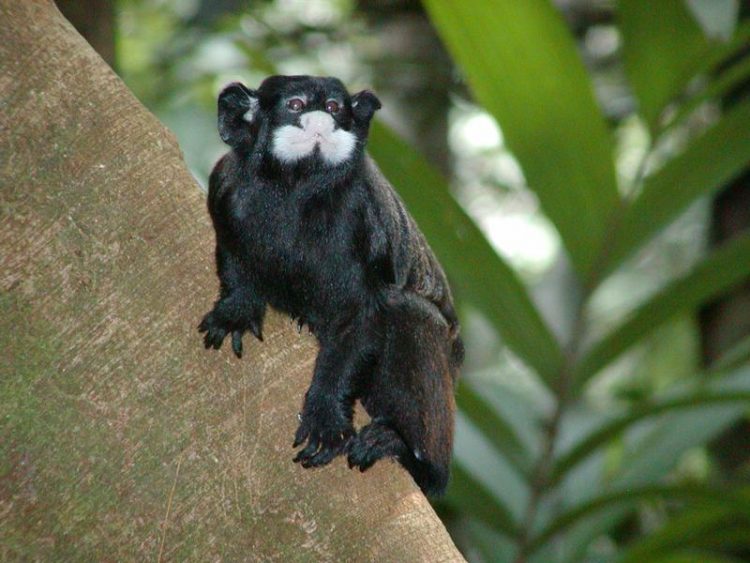Primates indispensable for regeneration of tropical forests

Moustached tamarins (Saguinus mystax) contribute crucially to the seed dispersal of the neotropical tree Parkia panurensis. Photo: Julia Diegmann
At the DPZ-field station Estación Biológica Quebrada Blanco in the Peruvian Amazonian lowlands, scientists studied how feeding, sleeping, and ranging habits of two species of New World monkeys affect the dispersal of the neotropical legume tree Parkia panurensis.
For this, the researchers observed a group of Brown-mantled tamarins (Saguinus nigrifrons) and Moustached tamarins (Saguinus mystax), who jointly moved through home ranges in search of edible plants which included Parkia trees.
Fruits from these trees are pods that contain 16 to 23 seeds, each of which is surrounded by edible gum. The monkeys feed on the gum content of the pods and at the same time swallow the Parkia seeds which are later defecated intact in a different area.
During behavioral observations, researchers recorded the food intake of tamarins as well as the location of the Parkia trees that they visited. In addition, they collected faecal samples of the tamarins that contained seeds. “With the help of genetic analyses of the DNA found in the seed coat, which is of maternal origin, we could make an exact assignment of the corresponding “mother tree” for the seeds”, says Eckhard W. Heymann from the DPZ. “This allowed us to determine how far Parkia seeds were dispersed by the monkeys.”
In order to analyze the effect of seed dispersal by monkeys on a spatial genetic level, the scientists examined three different developmental stages of the trees. In addition to the seeds that contain the plant embryo, they collected leaves from young and mature Parkia trees in the home range of tamarins. “With the help of analysis from microsatellites, short repeated DNA sequences, we were able to identify genetic similarities of individual trees”, says Heymann.
The analysis of the spatial genetic structure of the Parkia population revealed a significant genetic relationship of the plant embryos and young trees within a radius of 300 meters, which coincides with the distance within which most seeds are dispersed by the tamarins. For mature trees, the relationship was reduced to a radius of only up to 100 meters.
“In tropical rain forests, the seeds of 80 to 90 percent of trees and lianas are dispersed by animals. In addition to primates, birds and bats are the major animal groups that are responsible for seed dispersal”, says behavioral ecologist Heymann. “For the plants, transport of their seeds is extremely important. As sedentary organisms, this is the only way that their offspring – the embryos contained in the seeds – can reach appropriate sites for germination and growth. Furthermore, this reduces the density-dependent mortality which occurs when the seeds fall under the mother plants,” says Eckhard W. Heymann. Fruit-eating primates such as tamarins are therefore invaluable to the natural regeneration and diversity of ecosystems in which they live.
Original publication
Bialozyt, R., Lüttmann, K., Michalczyk, I.M., Saboya, P.P.P., Ziegenhagen, B., Heymann, E.W. (2014): Primate seed dispersal leaves spatial genetic imprint throughout subsequent life stages of the Neotropical tree Parkia panurensis. Trees DOI 10.1007/s00468-014-1061-7 (open access)
Contact
Prof. Dr. Eckhard W. Heymann
Tel: +49 551 3851-123
E-Mail: eheymann@dpz.eu
Dr. Susanne Diederich (Communication Department)
Tel: +49 551 3851-359
E-Mail: sdiederich@dpz.eu
Weitere Informationen:
http://link.springer.com/article/10.1007%2Fs00468-014-1061-7#page-1 – Link to the original publication
Media Contact
All latest news from the category: Life Sciences and Chemistry
Articles and reports from the Life Sciences and chemistry area deal with applied and basic research into modern biology, chemistry and human medicine.
Valuable information can be found on a range of life sciences fields including bacteriology, biochemistry, bionics, bioinformatics, biophysics, biotechnology, genetics, geobotany, human biology, marine biology, microbiology, molecular biology, cellular biology, zoology, bioinorganic chemistry, microchemistry and environmental chemistry.
Newest articles

First-of-its-kind study uses remote sensing to monitor plastic debris in rivers and lakes
Remote sensing creates a cost-effective solution to monitoring plastic pollution. A first-of-its-kind study from researchers at the University of Minnesota Twin Cities shows how remote sensing can help monitor and…

Laser-based artificial neuron mimics nerve cell functions at lightning speed
With a processing speed a billion times faster than nature, chip-based laser neuron could help advance AI tasks such as pattern recognition and sequence prediction. Researchers have developed a laser-based…

Optimising the processing of plastic waste
Just one look in the yellow bin reveals a colourful jumble of different types of plastic. However, the purer and more uniform plastic waste is, the easier it is to…



